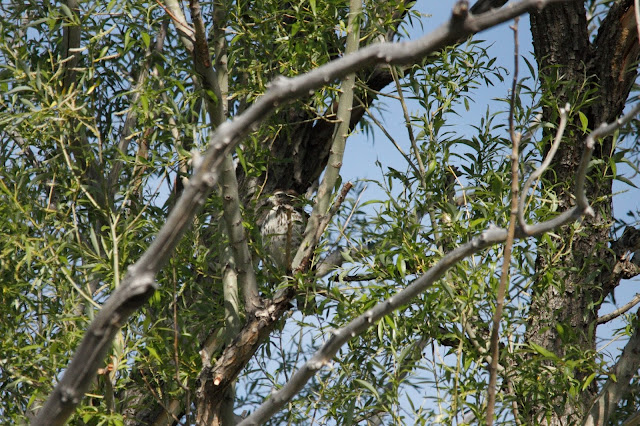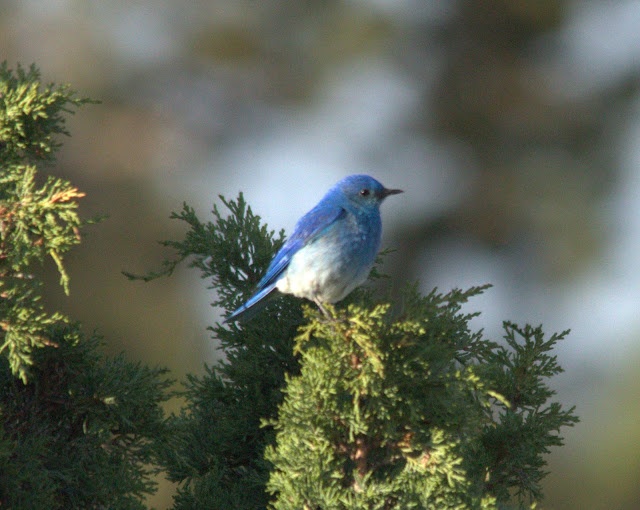This year my Harney County trip included a swing through Lake County.
All my stops mentioned in this blog are marked on the map at the very bottom.
My first stop was Summer Lake WMA. I arrived at about 3:30 in the afternoon. A male American Avocet was watching a female (bill is more sharply bent at end on female).
A few Black-crowned Night-Herons were flying by.
I did not know Tree Swallows marked their territory and I certainly did not know they did it in such a fashion. This fellow declined to comment on the situation.
After a nice start to my SE Oreogn trip at Summer Lake , I went down to camp at Goose Lake State Park below Lakeview. What a great spot. There was water in the lake, which provided stilts and avocets with plenty of habitat.
This is the view of the lake from the park. Hard to believe, but if the water levels get high enough to actually drain out of the lake the water enters the ocean through the Golden Gate.
The Warner Mountains border the lake on the east in Oregon. You are looking into California, the road into the park is the last right-hand turn off 395 before you leave Oregon.
The lake can be viewed from the end of the road. The California border is roughly straight out on the left. Trees and brush surround the actual park, lots of habitat to bird.
A flock of Black-necked Stilts out on the marsh. Avocets, Wilson's Phalarope, Wilson's Snipe and Sandhill Cranes were out on the marsh as well.
All the normal birds you would expect at a place in Harney County were here. This should be a fantastic place to hunt for rarities. Lots of Yellow Warblers were singing.
On my way out of the area, I visited the easily accessible Lakeview water treatment area. There is a nice gravel road right next to the fences. This male American Avocet was out swimming. I should add these areas are all on the Basin and Range birding loop and have signage at the sites stating such.
Female Cinnamon Teal or Blue-winged Teal? Check out the face pattern and head and bill structure.
White-faced Ibis, an adult Glossy Ibis would have a brown eye with a bluish edge to the skin area and dark gray legs with red on the joint.
After Lakeview, I headed up into the Warner Mtns.
I visited the area where Broad-tailed Hummingbirds were found last year, no luck this year. Dusky Flycatchers were calling along with other forest birds.
I headed on over to Denio and up to Fields on Thursday afternoon. I poked around Fields in the late afternoon. I spent a very windy night at Arizona Creek.
Fields had all the typical birds, Bullock's Orioles are the more vocal of the gang.
House Wrens are common in the right habitat.
This small empid was in Fields on Friday morning. It was obviously smaller than the Gray Flycatchers nearby. The large headed look, dark wings with bolder white wing bars, whitish throat, pale yellow wash across the belly. wider convex-sided bill and a whit call, made me go with Least Flycatcher.
On Saturday morning , after a night at Cottonwood Creek, I went back to Fields. This buteo was chased into the trees by a kestrel. Dave and Shawneen saw where it landed. It was small with a white throat and a bold face pattern, light streaks down the sides of the chest. You can see the black moustachial mark as well. Broad-winged Hawk.
Hiding back in the trees.
I went back to Cottonwood Creek to check out the hummingbird feeders Trent had set up at his camp. I found one Black-chinned. This Chukar was watching over things.
I wandered up into the sage to photograph Black-throated Sparrows. Lots of lizards were out. A male Long-nosed Leopard Lizard. The females have orange spots on the side. Some folks looking for reptiles told me they are one of the top predators out there.
I am going with Western Whiptail.
I am always careful wandering Cottonwood Creek and other creeks in Harney County. Never step into a bush and always be sure any stick you step on has the chance to move out of the way.
This Western Rattlesnake (Great Basin?) slithered into a sagebrush as I passed by. I saw its tail disappear in the bush right next to me. I heard its scales scrape together as it took a breath, I always thought I hear them hiss but Trent corrected me, it is expanding scales you hear. It sat quietly under the sage while I watched it. I even broke a few branches to get a better photo and it did not budge. All it wanted to do was get away from me and to stay safe.
I continued on my sparrow hunt and then went back to my car, passing by Trent and his family gang, I offered to show them the snake after they were done with breakfast. We went back up after they ate and my failed attempt to find some gnatcatchers. The snake was gone from its spot, we could not locate it until I looked back in the same bush one more time. It had moved over to a shadier side, a few of us had looked in the bush and missed it. You can see how they vanish when in the center of these bushes.
So never step on a bush, walk slowly to give them a chance to move out of the way, and understand all they want to do is to avoid you. We moved it around a bit with a lizard hoop and it still only gave a very short rattle.
This Gopher Snake was in the same area the day before.
Saturday night I went to South Steens Campground. Heading up out of the Alvord Desert into the Catlow Valley was this Loggerhead Shrike.
Usually this time of year South Steens is a quiet spot. It was darn near full. I like birding the South Steens Road in the early morning, every now and then you hear a Long-eared Owl hoot. Perhaps heard a female , but just a few sounds so not enough to get good id.
The morning sun coming up over the Blitzen Gorge.
This stretch of the road is after you pass by the first gate going up, it is always good for all the sage birds and the junipers up on the rim have held owls. One year I saw a Pinyon Jay in area. A bit farther up this road Black-throated Gray Warblers nest.
Mountain Bluebirds are common.
Brewer Sparrows are common on these trips.
Ash-throated Flycatchers are reliable at Page Springs, go up the wilderness trail on the side of the canyon and sit and listen for a bit. I had to climb up out of the canyon to get this guy.
They are also at Sage Hen Rest Area.
Blue-gray Gnatcatchers are not that tough to find in the sage, juniper and Mt Mahogany of Harney County. There was a pair at Cottonwood Creek that only showed themselves when I was gone. When active, they are noisy, active and can be pished in to very close range. I found mine at the Sage Hen Rest Area. This is one of them. I could not age it, but it is a male with the black line from bill over the eye. I was thinking the brownish primaries would mean a second-year bird, but I think it is more complicated than that.
The map of the route:
Thanks for the visit, I am looking forward to my next trip to SE Oregon.
I would like to thank my daughter, Mariah, for using her photo editing skills on the Tree Swallow photo ;)






















































